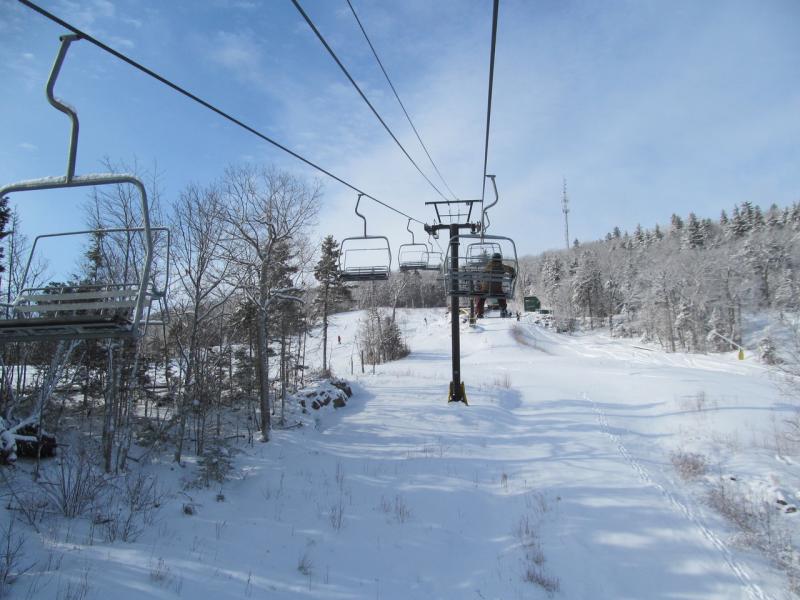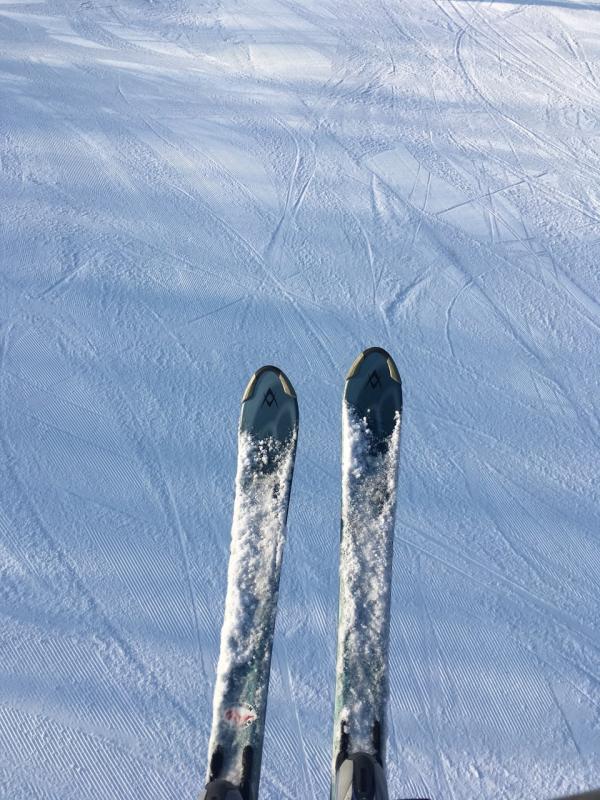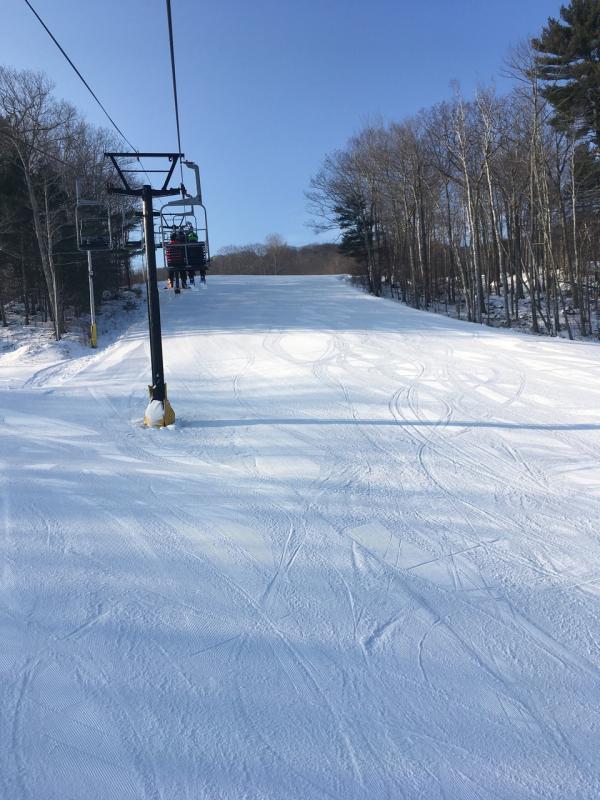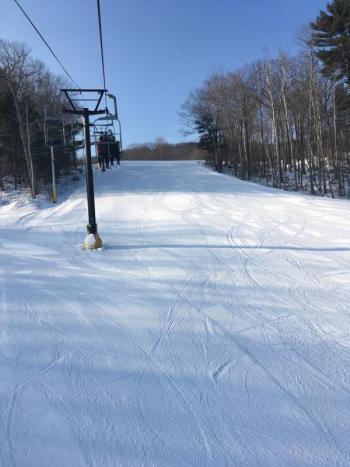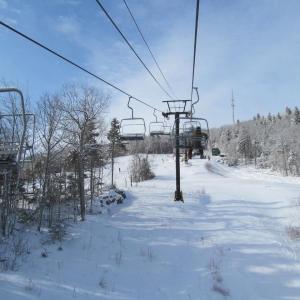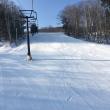Leap of Faith: Chairlift Evacuation at the Snow Bowl
“You’ll hear a ‘pop,’ kind of like the sound of a .22, as we shoot the line over the cable,” the red-coated ski patroller announced to the lodge full of parka-clad folks last Saturday afternoon. The crowd of 65-plus was split into roughly four sections: ski patrol in their red coats with white crosses; firefighters in their neon glowing yellow jackets and heavy boots; mountain rescue professionals, by far the smallest of the bunches, and the most varied, from wiry, compact men to larger, broad men in yellow neon vests; and the last, motley group I was part of, the volunteers, ranging from teen boys who had done it before to blue-coated mountain stewards, and then the regular old skiers like me, there to play victim in the Camden Snow Bowl’s Chairlift evacuation drill.
It was getting dark as Duncan Matlack and Jeff Nathan, the two patrollers addressing the crowd, spoke. It was 4:45 on a January afternoon, the ski hill emptied of skiers but full of snow. We were fortunate the temperature was mild, in the 30s, with a rising wind and the threat of rain.
“When will we be done?” one of my fellow volunteers inquired as the information session ran down.
“We expect to take 20 minutes to load the lift, starting with the ski patrol. Once the lift is loaded and stopped we hope to get you all down within an hour,” the optimistic drill coordinator replied.
And with that we were off, the patrollers to get up the lift and onto the trail, the firefighters and mountain rescuers to finish suiting up, placing the large firetruck with its lights facing the hill, and the 30 or so volunteers heading to the lift.
We had the option of wearing skis or not, and most of us had chosen not to. We had been instructed to dress warmly. I wore my standard ski gear and helmet, with a few extra layers midsection, despite the relative warmth of the night. As our time stretched well beyond the allotted hour I was glad for my additional layers.
As the clump of volunteers ambled across the snow to the double chairlift we also wove ourselves into pairs. There was lots of banter and camaraderie, people unknown to one another minutes before struck up conversations—remarking on the bright lights of the firetruck, speaking of climbing trees, and the young man in line next to me bragging that this would be his third time volunteering for this drill.
As the line formed and tightened I made the acquaintance of my chairlift partner, his blue jacket signifying his role as mountain steward, those ambassadors of the area who do everything from check lift tickets to assist skiers on the hill.
The line crawled along as the patrollers, wearing skis, were loaded onto the lift. Some volunteer pairs were split into singles as the drill master worked to ensure that each chair had a victim. Thrilled to retain my partner—I had been dreading this drill ever since I had heard about it—I shuffled along, and pretty soon Chris, my lift partner, and I were aboard.
Why, you might ask, if I had been dreading the drill, was I participating? I have skied all my life and have always wondered what happens if you are stuck on the lift when it breaks.
Fascination, curiosity, and a frank desire to face my fears head on—I don’t like heights (the fact that I ride a chair anyway is testament to how much I like skiing)—all propelled me as I walked aboard that chairlift on that dark Saturday night.
(My fear of heights was also the reason I didn’t want to sit alone on the chair as the drill progressed, so I was pleased to have the boy behind me and the gentleman in front of me volunteer for solo slots.)
As we rode up the lift Chris told me he had volunteered once before for this drill, earlier in the fall, before snow, in daylight, on the triple chair, when the patrollers had only filled 3 chairs with victims.
Soon the chair, stopped, and wouldn’t you know Chris and I were suspended at the chair’s highest point off the ground. Once stopped I looked down, remembering all the times while skiing and being carried to the top l’d wondering exactly what did happen if the lift broke down, if folks ever had to jump that distance down to the snow.
As the dark closed in and we got used to the stillness, I knew not to look down again. I knew that I had to keep my mind engaged in other topics and not think about how high aloft I was. Thank heavens for my lift partner, an exquisite conversationalist as well as someone with deep connections to my extended family, as we came to discover while we talked for the next 90 minutes while awaiting rescue.
After the lift stopped the mountain activity accelerated. Firefighters and ski patrollers spread down the hill, one team for about every 4 chairs. As had been explained to us, the firefighters would belay those of us dropping from the chairs; the patrollers would give instructions as well as helping with the belays.
Ten or so minutes into our dark night a patroller skied below us, headlamp ablaze, shouting upward that a lift evacuation was underway, asking us to be patient, and to help one another stay warm. He also took our names. About 20 or 30 minutes later we would be visited again, asked this time how we were doing, if we had any health concerns. As I answered I imagined a real evacuation, perhaps in a blowing snowstorm, and could imagine any number of other answers I might give, if I were colder, alone, panicked or hurt.
As Chris and I chatted I turned and kept my eye on the solo teen aloft in the chair behind us. His rescue team had already shot the line up and over the cable, positioning the rescue sling, instructing him to bring it on the chair under the safety bar. I was fascinated as the rescuer’s headlamps illuminated the boy, listened while they instructed him to pull the white sling down over his head, under his arms. Next they told him to slide the wooden seat under his bottom. The boy mistakenly raised the lift’s safety bar—was then immediately instructed to lower it, told that the bar would rise on its own. The ski patroller’s “On belay?” was the question and signal for the firefighters to affirm their preparedness for the skier’s descent. I was captivated, mouth open, as the patroller at the bottom next instructed the skier to slip his bottom off the chair. I watched, captivated, as the young man, high in the air, slowly pushed himself off into the dark night. The rescue line went taut, the belay holding tight as the boy swung free of the chair. Then the firefighters lowered him.
I turned back to face front, aware that soon I would be asked to undertake the exact same moves.
Luckily my chairlift partner and I had a lot of fascinating conversation topics, from plate tectonics to high school ski trips to summer trips to Great Cranberry Island—because without this ongoing, meandering talk I am pretty sure my mind would have gone to any number of catastrophic outcomes of my soon-to-be evacuation.
As we talked Chris and I watched the skier in the chair ahead of us get evacuated and put into a toboggan—they were simulated that he had an injured knee.
As one patroller skied off with that victim the three remaining emergency responders then fiddled with the throw line, trying to lift it over the chair ahead of us. We watched and listened for several minutes as they worked on that snafu, realizing yet again how drills like the one we were in trained for any number of possible difficulties. You never know what you might learn.
Soon enough the orange line was in front of our chair, and the three rescuers below us ready. I’m not sure if they asked our names again, but they did ask who was to go first, and I eagerly blurted out “I am.” My seat mate was gallant to allow me this—I did not want to be the last one dangling up there, alone.
SO it was my turn to reach for the sling on the orange rescue line, bring it in under the safety bar, get the rescue seat under my bottom, hoist the white sling over my helmet and under my arms. I missed the instruction about cinching the sling with the metal collar, but I did have a firm grasp on the rescue sling. Intellectually I knew I was then being held by that line, and would be safely belayed by the folks below, but the instruction to slide out, into the dark void of the night, off the chairlift, was truly mind blowing. Push my body off the chairlift dangling dozens of feet off the ground? Really?
“It’s a leap of faith,” my ski patrol rescuer shouted up to me. And slowly I did as I was told, holding the orange line, falling off the chair. Chris, my calm chairlift mate, was a huge presence, and soon enough there I was, dangling, twirling, getting lowered down from the chairlift.
It was a slow descent, my very cold feet hitting the snow almost 90 minutes from the time the rescue drill started. Once down and unhooked I looked up, saw the bottoms of Chris’ boots a long distance above. Chris was now the rescue subject, fitting the sling over his head.
And soon enough he was down, too. High fives all around as we awaited the ski patroller who was to escort us down the mountain.
“Do one thing a day that scares you” said Eleanor Roosevelt. And so I had last Saturday.
Molly Mulhern lives in Camden
Event Date
Address
United States

